Abstract
The effect of 19 antimicrobial agents on human polymorphonuclear leukocyte function was evaluated by chemiluminescence assays, yeast phagocytosis and killing, and lactate dehydrogenase release. Tetracycline and trimethoprim inhibited chemiluminescence and reduced killing at therapeutic concentrations of 2 microgram/ml. Cephalothin inhibited yeast killing at a concentration of 20 microgram/ml, but a significant depression of polymorphonuclear leukocyte chemiluminescence was encountered only at higher levels of 200 microgram/ml. The inhibition shown by these drugs was reversible. None of the other antimicrobial agents tested demonstrated inhibition of chemiluminescence, phagocytosis, or killing at usual clinical serum levels. No antimicrobial agent tested caused release of lactate dehydrogenase from polymorphonuclear leukocytes. The results suggest that therapeutic concentrations of tetracycline, trimethoprim, and cephalothin may inhibit optimal polymorphonuclear leukocyte microbicidal function.
Full text
PDF
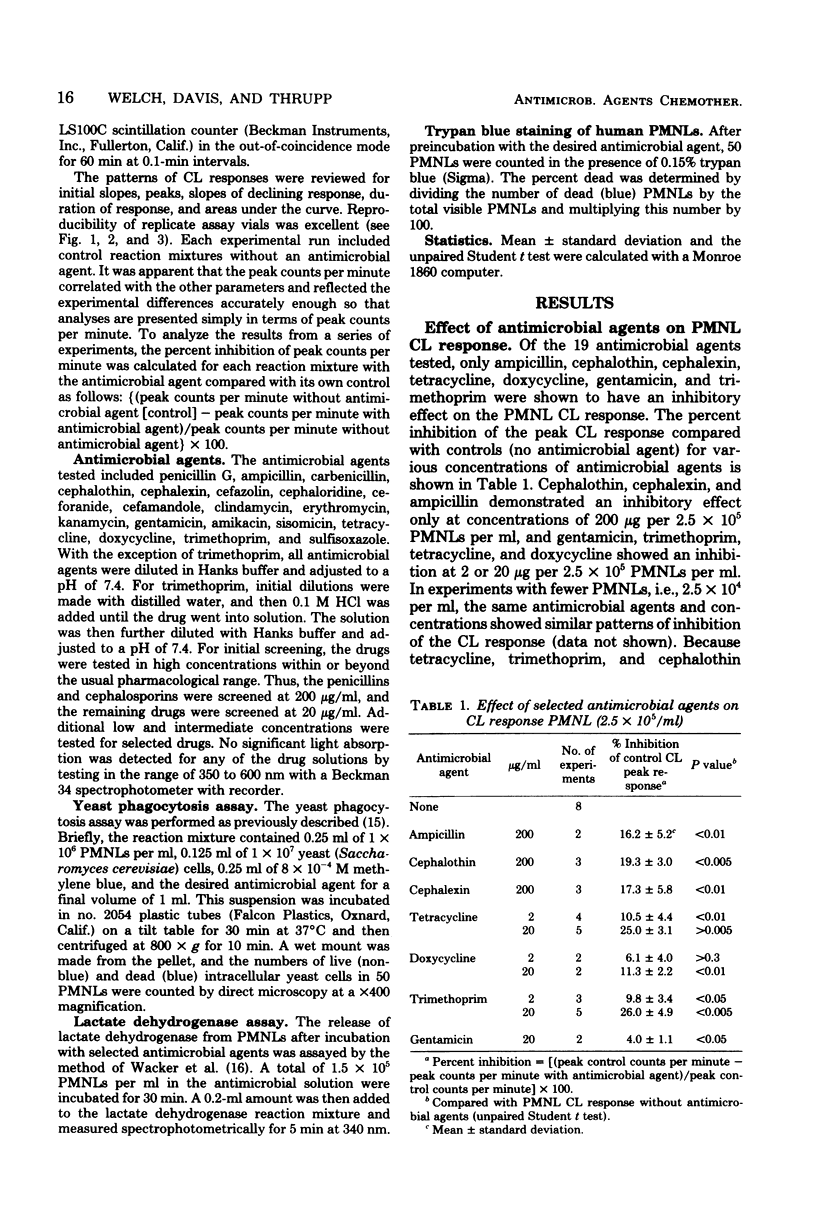
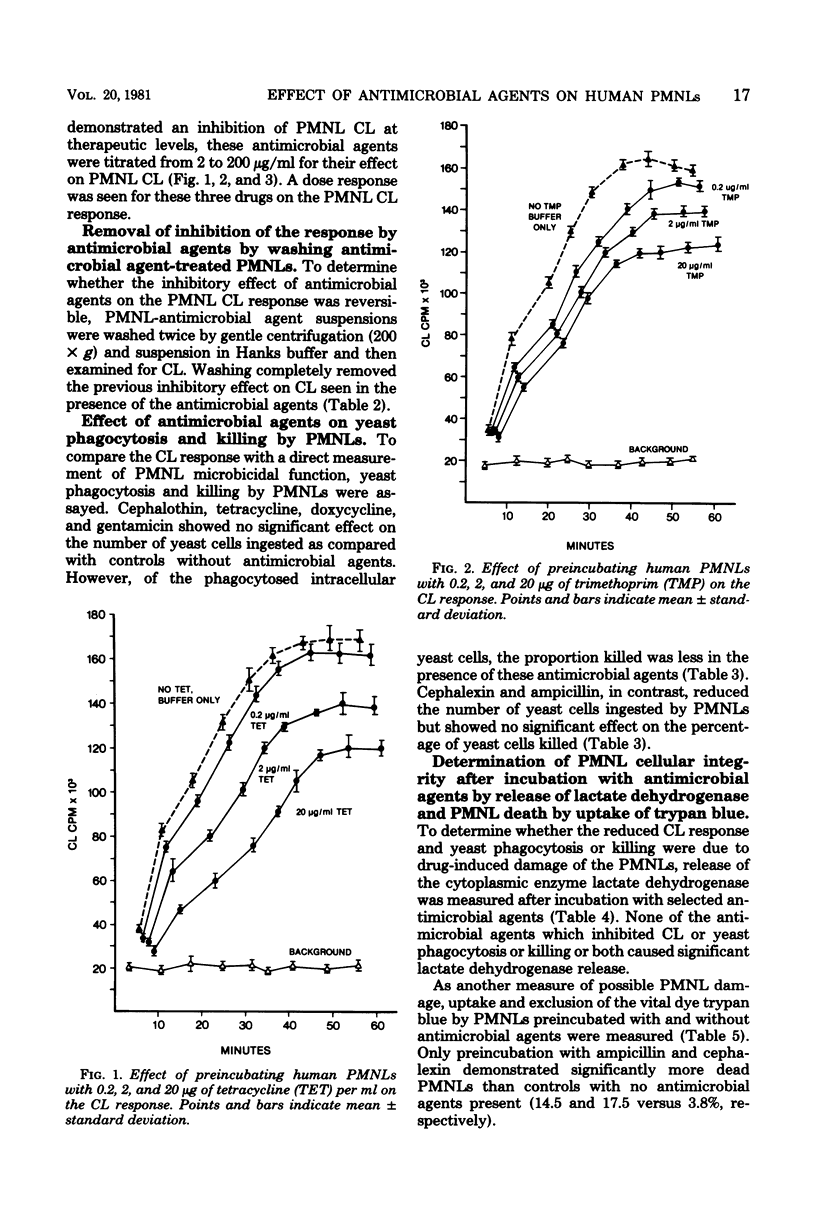
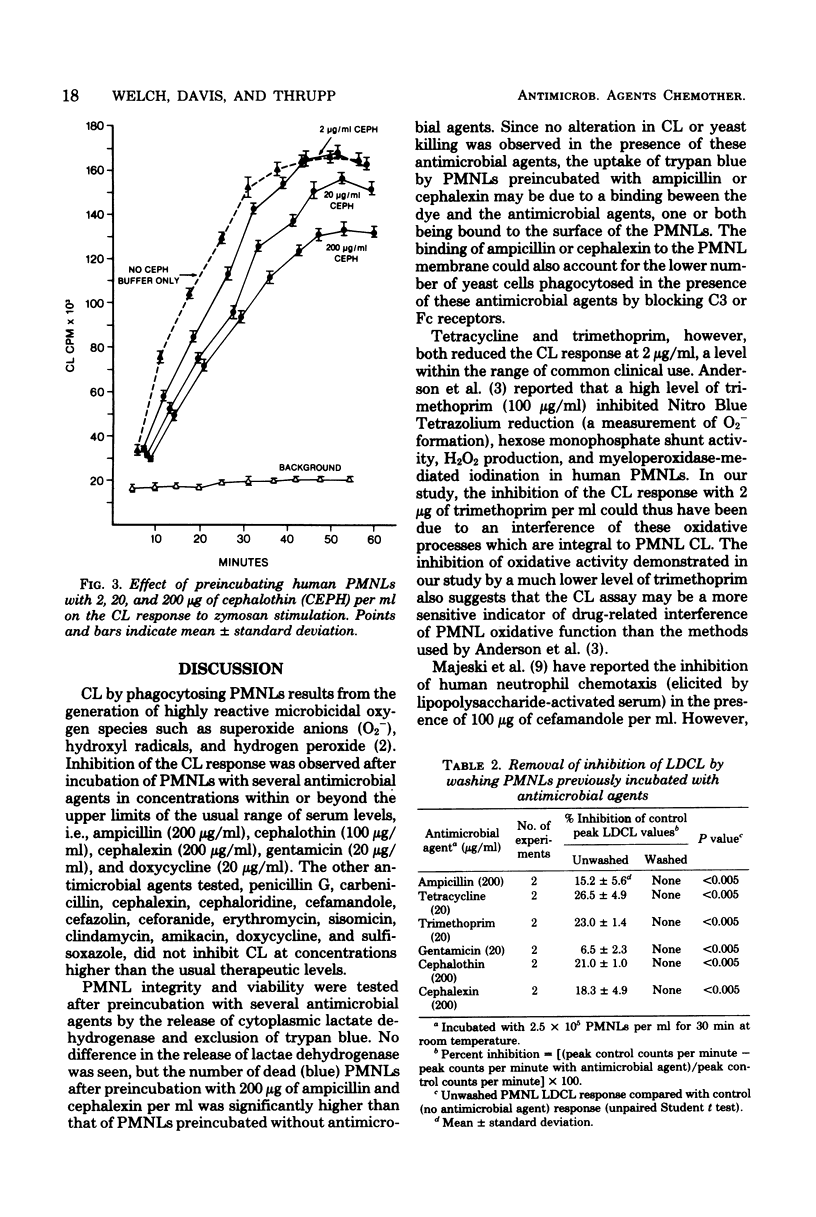
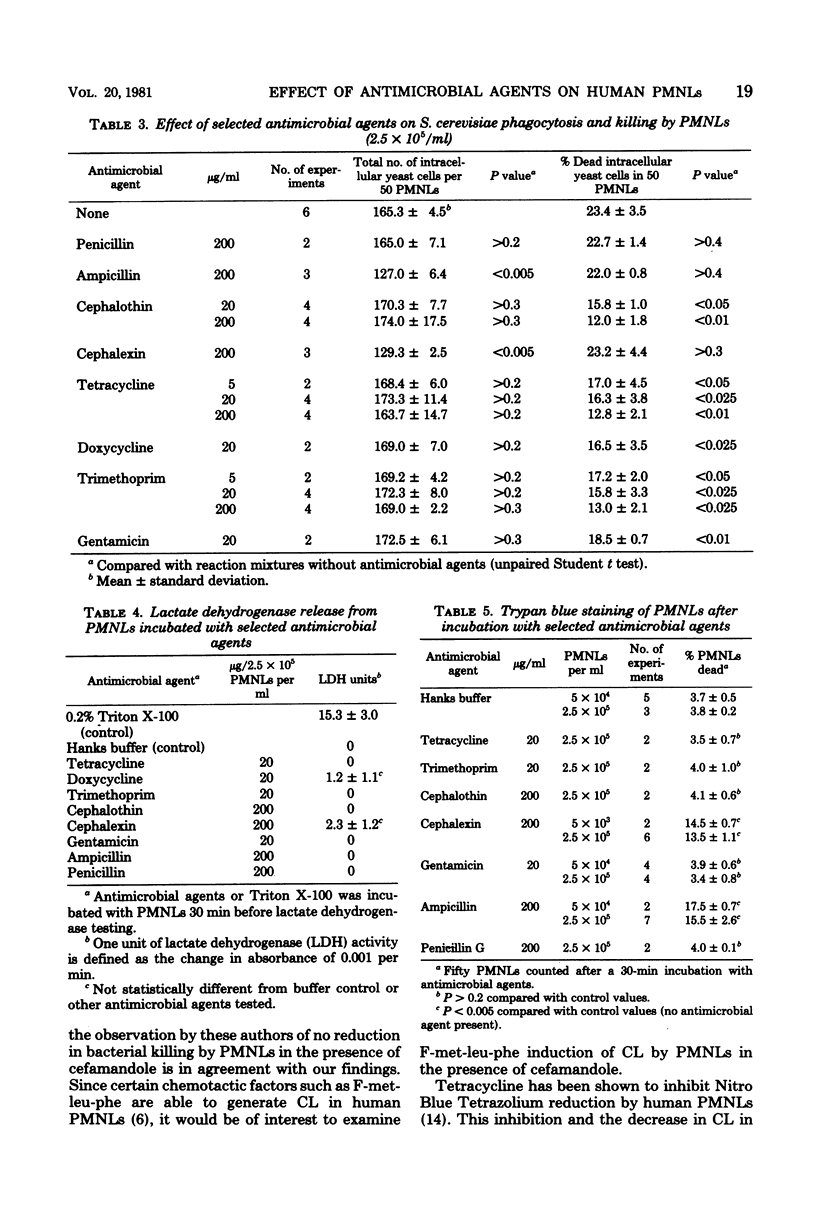
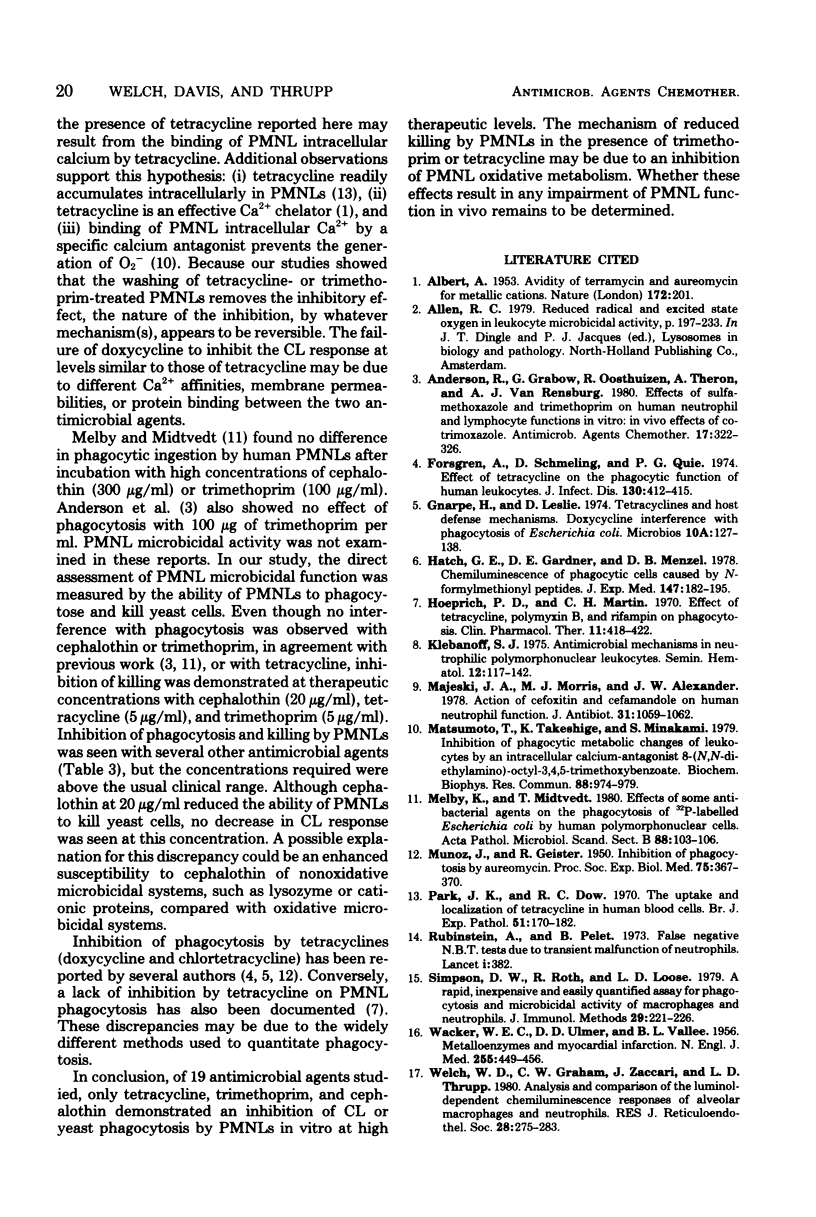
Selected References
These references are in PubMed. This may not be the complete list of references from this article.
- ALBERT A. Avidity of terramycin and aureomycin for metallic cations. Nature. 1953 Aug 1;172(4370):201–201. doi: 10.1038/172201a0. [DOI] [PubMed] [Google Scholar]
- Allen R. C. Reduced, radical, and excited state oxygen in leukocyte microbicidal activity. Front Biol. 1979;48:197–233. [PubMed] [Google Scholar]
- Anderson R., Grabow G., Oosthuizen R., Theron A., Van Rensburg A. J. Effects of sulfamethoxazole and trimethoprim on human neutrophil and lymphocyte functions in vitro: in vivo effects of co-trimoxazole. Antimicrob Agents Chemother. 1980 Mar;17(3):322–326. doi: 10.1128/aac.17.3.322. [DOI] [PMC free article] [PubMed] [Google Scholar]
- Forsgren A., Schmeling D., Quie P. G. Effect of tetracycline on the phagocytic function of human leukocytes. J Infect Dis. 1974 Oct;130(4):412–415. doi: 10.1093/infdis/130.4.412. [DOI] [PubMed] [Google Scholar]
- Gnarpe H., Leslie D. Tetracyclines and host defence mechanisms. Doxycycline interference with phagocytosis of Escherichia coli. Microbios. 1974 Jun-Jul;10A SUPPL(41):127–138. [PubMed] [Google Scholar]
- Hatch G. E., Gardner D. E., Menzel D. B. Chemiluminescence of phagocytic cells caused by N-formylmethionyl peptides. J Exp Med. 1978 Jan 1;147(1):182–195. doi: 10.1084/jem.147.1.182. [DOI] [PMC free article] [PubMed] [Google Scholar]
- Hoeprich P. D., Martin C. H. Effect of tetracycline, polymyxin B, and rifampin on phagocytosis. Clin Pharmacol Ther. 1970 May-Jun;11(3):418–422. doi: 10.1002/cpt1970113418. [DOI] [PubMed] [Google Scholar]
- Klebanoff S. J. Antimicrobial mechanisms in neutrophilic polymorphonuclear leukocytes. Semin Hematol. 1975 Apr;12(2):117–142. [PubMed] [Google Scholar]
- MUNOZ J., GEISTER R. Inhibition of phagocytosis by aureomycin. Proc Soc Exp Biol Med. 1950 Nov;75(2):367–370. doi: 10.3181/00379727-75-18201. [DOI] [PubMed] [Google Scholar]
- Majeski J. A., Morris M. J., Alexander J. W. Action of cefoxitin and cefamandole on human neutrophil function. J Antibiot (Tokyo) 1978 Oct;31(10):1059–1062. doi: 10.7164/antibiotics.31.1059. [DOI] [PubMed] [Google Scholar]
- Matsumoto T., Takeshige K., Minakami S. Inhibition of phagocytotic metabolic changes of leukocytes by an intracellular calcium-antagonist 8-(N,N-diethylamino)-octyl-3,4,5-trimethoxybenzoate. Biochem Biophys Res Commun. 1979 Jun 13;88(3):974–979. doi: 10.1016/0006-291x(79)91503-1. [DOI] [PubMed] [Google Scholar]
- Melby K., Midtvedt T. Effects of some antibacterial agents on the phagocytosis of 32P-labelled Escherichia coli by human polymorphonuclear cells. Acta Pathol Microbiol Scand B. 1980 Apr;88(2):103–106. doi: 10.1111/j.1699-0463.1980.tb02613.x. [DOI] [PubMed] [Google Scholar]
- Park J. K., Dow R. C. The uptake and localization of tetracycline in human blood cells. Br J Exp Pathol. 1970 Apr;51(2):179–182. [PMC free article] [PubMed] [Google Scholar]
- Rubinstein A., Pelet B. False-negative N.B.T. tests due to transient malfunction of neutrophils. Lancet. 1973 Feb 17;1(7799):382–382. doi: 10.1016/s0140-6736(73)90185-2. [DOI] [PubMed] [Google Scholar]
- Simpson D. W., Roth R., Loose L. D. A rapid, inexpensive and easily quantified assay for phagocytosis and microbicidal activity of macrophages and neutrophils. J Immunol Methods. 1979;29(3):221–226. doi: 10.1016/0022-1759(79)90309-0. [DOI] [PubMed] [Google Scholar]
- ULMER D. D., VALLEE B. L., WACKER W. E. Metalloenzymes and myocardial infarction. II. Malic and lactic dehydrogenase activities and zinc concentrations in serum. N Engl J Med. 1956 Sep 6;255(10):450–456. doi: 10.1056/NEJM195609062551001. [DOI] [PubMed] [Google Scholar]
- Welch W. D., Graham C. W., Zaccari J., Thrupp L. D. Analysis and comparison of the luminol-dependent chemiluminescence responses of alveolar macrophages and neutrophils. J Reticuloendothel Soc. 1980 Sep;28(3):275–283. [PubMed] [Google Scholar]


